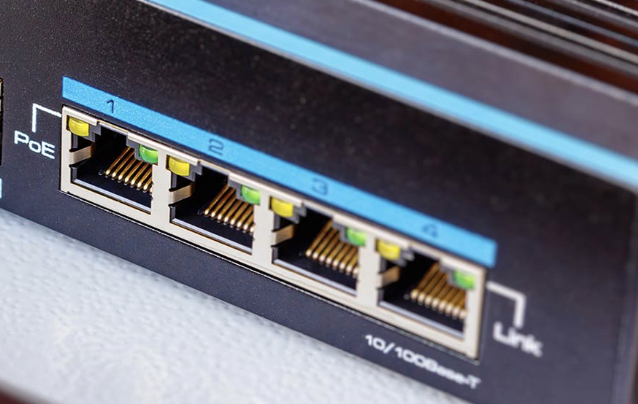
In the realm of networking and data transmission, Power over Ethernet (PoE) can be a game-changer. This innovative technology revolutionizes the way we power and connect network devices, offering convenience, flexibility, and efficiency. In this blog, we’ll delve into what PoE is, explore its diverse use cases, and provide some general tips, including an overview of active and passive PoE and other common specifications to know.
What is Power over Ethernet (PoE)?
Power over Ethernet (PoE) is a technology that enables the simultaneous transmission of data and electrical power over standard Ethernet cables. Instead of relying on separate power cords or electrical outlets, PoE simplifies device installation and management by integrating power delivery directly into the existing Ethernet infrastructure. It employs a technique called “phantom power,” which utilizes unused wire pairs in the Ethernet cable to deliver low-voltage direct current (DC) power.
Active PoE
Active PoE is a type of PoE that requires a negotiation process between the power sourcing equipment (PSE) and the powered device (PD) to determine the power requirements. This negotiation allows the PSE to deliver the precise amount of power needed by the PD, ensuring optimal power delivery and compatibility. Active PoE is typically used in higher-power applications, such as pan-tilt-zoom cameras, Wi-Fi access points, and video conferencing systems.
Passive PoE
Passive PoE, on the other hand, does not involve a negotiation process between the PSE and PD. Instead, power is continuously supplied to the PD, regardless of its power requirements. This can lead to compatibility issues if the PD is not designed to handle the power delivered. Passive PoE is commonly found in lower-power applications, such as IP phones, basic security cameras, and small-scale IoT devices.
PoE Input vs PoE Output
Routers may support PoE input or output. Input means that it can use PoE to power the router itself. Output means that it can power external devices like IP phones, Ethernet switches, or WiFi access points. The PoE output capability of a switch or injector is usually defined by the PoE standard it supports (such as IEEE 802.3af, 802.3at, or 802.3bt). This determines the maximum amount of power that can be delivered. It’s important to note that devices can simultaneously act as PoE input and PoE output. For example, a PoE switch can receive power from a higher-level power source and distribute it to connected PDs. This makes it both a PoE input and a PoE output device.
Common PoE Specifications to Know
- PoE Standards: The Institute of Electrical and Electronics Engineers (IEEE) has defined various PoE standards, including IEEE 802.3af, IEEE 802.3at, and IEEE 802.3bt. These standards specify the power levels and protocols for PoE, ensuring interoperability between PoE devices from different manufacturers.
- Power Budget: The power budget refers to the maximum power that a PoE switch or injector can supply to connected PDs. It’s important to consider the power requirements of your devices and ensure that the power budget of your PoE infrastructure can accommodate them.
- Maximum Power Delivery: PoE standards define the maximum power that can be delivered to a single PD. For example, IEEE 802.3af (PoE) can deliver up to 15.4 watts, IEEE 802.3at (PoE+) can deliver up to 30 watts, and IEEE 802.3bt (PoE++) can deliver up to 60 or 100 watts depending on the implementation.
- Cable Length and Quality: Ethernet cable length and quality can affect PoE performance. Longer cable runs or lower quality cables may experience voltage drop, reducing power delivery. It’s advisable to use high-quality Ethernet cables suitable for PoE applications and consider the maximum cable length supported by your PoE devices.
- PoE Classes: PoE devices are categorized into different classes (0-8) based on their power requirements. The class is determined by the amount of power needed by the PD. Understanding the class of your devices is essential when planning your PoE deployment.
PoE: Empowering Networks with Simplicity, Flexibility, and Reliability
Power over Ethernet (PoE) has become an indispensable technology in modern network deployments, revolutionizing the way power and data are delivered to network devices. By integrating power delivery and data transmission over a single cable, PoE offers numerous benefits that greatly enhance network infrastructure.
With PoE, you have a simplified setup. There’s no need for separate power cords or electrical outlets, reducing clutter and streamlining the setup process. This not only saves time and effort but also allows for greater flexibility in device placement. Moreover, PoE offers increased flexibility in network management. Power can be centrally controlled and managed through the PoE switch or injector, enabling remote power management and monitoring. This allows network administrators to easily power cycle devices, remotely troubleshoot power-related issues, and optimize power distribution to meet the demands of the network.
Understanding the options of active and passive PoE, as well as being familiar with common PoE specifications, empowers organizations to make informed decisions when implementing PoE infrastructure. Knowing the specific PoE standards, power budgets, cable length limitations, and device classes helps in planning and designing a PoE network that meets the requirements of the devices being powered.

